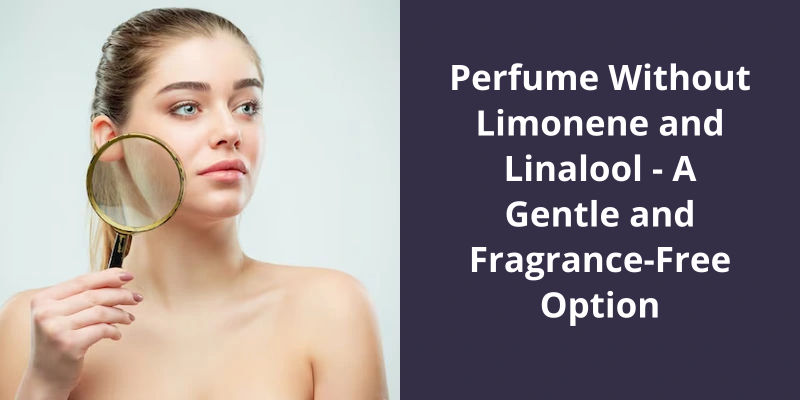Perfume without Limonene and Linalool can be an excellent choice for people with sensitive skin or those who prefer a milder scent. These are common ingredients in many fragrances, known for their distinct citrus and floral aroma. However, some people might have an allergy or sensitivity to these compounds. Finding a perfume without Limonene and Linalool might take some time, as not all manufacturers disclose all their ingredients. Opt for fragrances marked as hypoallergenic or specifically labeled as free from these substances. Also, keep in mind that completely organic, natural, or vegan perfumes can also be a safe choice.

What Is the Scent of Linalool?
Linalool is a versatile and widely used fragrance ingredient in the world of perfumery. It’s commonly found in the top notes of many perfumes and can be detected in a significant percentage of cosmetic products.
It’s floral notes give off a sense of femininity and grace, while it’s citric undertones provide a refreshing and invigorating twist. The overall effect is a fragrance that’s both uplifting and soothing, creating a balanced and harmonious olfactory experience.
It blends well with a variety of other fragrance ingredients, allowing perfumers to create complex and multi-dimensional scents.
With it’s floral, citric, fresh, and sweet aroma, it’s become a staple in the creation of pleasant and invigorating scents.
What Are Some Common Perfumes or Cosmetic Products That Contain Linalool?
- Chanel No. 5
- Dior Sauvage
- Gucci Bloom
- Lancome La Vie Est Belle
- Paco Rabanne 1 Million
- Yves Saint Laurent Black Opium
- Versace Eros
- Jo Malone London English Pear & Freesia
- Hugo Boss Boss Bottled
- Tom Ford Black Orchid
Limonene and linalool are versatile compounds that find extensive use in various household and industrial products. Limonene, derived from citrus fruit peels, and linalool, found in numerous plants, serve as key ingredients in hygiene products, perfumes, detergents, and even industrial applications. Their widespread presence highlights the importance of these compounds in everyday life.
What Is Linalool and Limonene Used For?
They’re often used to provide fragrance and enhance the sensory experience of these products. However, some individuals may have sensitivities or allergies to limonene and linalool, leading to skin irritations, rashes, or allergic reactions. For people with such sensitivities, finding fragrance-free options can be a challenge.
Some manufacturers may use natural alternatives, such as essential oils derived from plants, which can still be irritating to sensitive individuals. It’s best to opt for products that are specifically formulated to be hypoallergenic and suitable for sensitive skin.
Additionally, it’s always a good idea to perform patch tests before applying any new product to your skin. This way, you can determine if you’ve any adverse reactions before using it extensively. Patch testing involves applying a small amount of the product to a small area of your skin and monitoring it for any signs of irritation or allergy.
By choosing carefully and conducting patch tests, you can find gentle and fragrance-free alternatives that suit your needs.
The Benefits and Uses of Linalool and Limonene in Fragrance and Cosmetic Products.
Linalool and limonene are natural compounds commonly used in fragrance and cosmetic products. They’re both derived from plants and offer a variety of benefits.
Linalool has a floral and slightly sweet scent and is often used as a fragrance ingredient. It’s also known for it’s calming and soothing properties, making it a popular choice in aromatherapy products. Linalool can be found in essential oils like lavender, rose, and neroli.
Limonene, on the other hand, has a fresh and citrusy aroma. It’s commonly extracted from citrus fruits like oranges and lemons. Limonene not only adds a pleasant scent to products but also has antimicrobial and antioxidant properties, making it useful in cosmetic formulations.
While linalool and limonene are widely used and generally well-tolerated, some individuals may have sensitivities or allergies to these compounds. In such cases, it may be necessary to opt for fragrance-free products that don’t contain limonene and linalool.
If you prefer a gentle and fragrance-free option, there are plenty of products available on the market that are specifically formulated without these compounds. These products are designed to minimize the risk of irritation or allergic reactions, making them suitable for those with sensitive skin or fragrance allergies.
When choosing fragrance and cosmetic products, it’s always important to carefully read ingredient labels and consider your individual sensitivities or preferences. Whether you prefer products with or without limonene and linalool, there’s a wide range of options available to meet your specific needs.
Limonene, a colorless liquid with a delightful lemon-like aroma, is a key component found in the rinds of citrus fruits. This natural compound is widely employed by perfumers to infuse a distinctive scent or flavor into various everyday items.
What Is the Aroma of Limonene?
Limonene, with it’s distinct citrus aroma, is a commonly used fragrance ingredient in many perfumes, soaps, and cleaning products. It’s refreshing scent is reminiscent of freshly peeled oranges and lemons, making it a popular choice for those who enjoy a zesty and uplifting fragrance. Additionally, limonene also boasts antimicrobial properties, making it a practical ingredient in cleaning and personal care products.
Despite it’s popularity, some individuals may have sensitivities or allergies to limonene. This has led to a growing demand for fragrance-free options that don’t contain this particular ingredient. Manufacturers have responded by creating perfume formulas that exclude limonene and other potentially irritating substances, providing a gentle and scent-free alternative for those with sensitive skin or scent sensitivities.
These alternatives maintain the essence of a perfume, allowing individuals to experience the beauty and elegance of fragrance without the risk of irritation or allergic reactions.
Choosing a perfume without limonene and linalool can be especially beneficial for individuals with asthma, eczema, or other skin conditions. The absence of these potential irritants reduces the risk of triggering symptoms and allows individuals to enjoy the sensory pleasure of a fragrance without compromising their health. It’s essential to read product labels carefully and look for explicit claims of being limonene and linalool-free when searching for a perfume suitable for sensitive individuals.
This gentle and fragrance-free option caters to a broad range of users and allows for a more inclusive and enjoyable scent experience.
Source: Limonene – Wikipedia
When it comes to choosing essential oils, it’s important to consider the ingredients and their potential effects. Some individuals may have sensitivities to certain compounds, such as linalool, commonly found in many essential oils. However, there are various alternatives that don’t contain linalool but still provide delightful aromas and potential therapeutic benefits. Let’s explore a list of essential oils that offer a safer option for those with sensitivities, including Cedarwood, Eucalyptus, Sweet Fennel, Clove, Frankincense, Carraway, Labdanum, Sandalwood, Patchouli, Myrrh, and Vetiver.
Which Essential Oils Do Not Contain Linalool?
Perfume lovers with sensitivity to linalool often face a challenging task of finding fragrance options that suit their needs. Linalool, a common ingredient found in many essential oils, can sometimes cause skin irritation and allergic reactions. However, there are several essential oils that don’t contain linalool, offering a gentle and fragrance-free solution.
One such alternative is cedarwood essential oil, which has a warm and woody aroma. It not only adds depth to the scent but also has a calming effect on the mind. Eucalyptus essential oil, with it’s refreshing and invigorating scent, is another great choice. It can provide a cooling sensation and help clear the sinuses.
Sweet fennel essential oil has a slightly herbal and licorice-like aroma. It adds a unique twist to any fragrance blend. Clove essential oil, with it’s spicy and rich scent, is also a worthy consideration. It’s a comforting and warm effect on the senses, making it a perfect choice for autumn and winter perfumes.
Frankincense essential oil, known for it’s resinous and balsamic aroma, is a versatile option. It lends a mystical and spiritual touch to any fragrance composition. Carraway essential oil, with it’s sweet and herbal fragrance, is another standout choice. It can be used to add a touch of freshness to perfume blends.
Labdanum, with it’s warm and amber-like scent, is a classic option that adds depth and complexity to fragrances. Sandalwood, often praised for it’s creamy and woody aroma, is another excellent choice.
Patchouli essential oil, renowned for it’s earthy and musky scent, adds a touch of mystery and sensuality. Myrrh essential oil, with it’s warm and resinous fragrance, brings an ancient and exotic vibe to the blend. Lastly, vetiver essential oil, with it’s deep and smoky aroma, offers a sophisticated and luxurious element to any perfume creation.
Linalool, a naturally occurring compound, is known for it’s distinct scent that’s often associated with lavender. However, it’s fragrance isn’t limited to lavender alone. More specifically, (S)-(+)-linalool, which can be derived from coriander oil and sweet orange, possesses a delightful aroma reminiscent of sweet lavender with a subtle citrus undertone. Interestingly, linalool can also be found in tomatoes, adding a unique fragrance to these versatile fruits.
Does Linalool Smell Like Lavender?
Linalool is commonly associated with lavender due to it’s similar fragrance profile. It’s a sweet and floral scent with a hint of citrus. Many people find the scent to be calming and relaxing.
It can also be found in other plants and fruits, such as coriander and sweet orange. The presence of linalool in coriander gives it a slightly citrusy and floral aroma. Similarly, sweet orange contains linalool, which adds a subtle touch of citrus to it’s fragrance.
Interestingly, linalool can even be found in tomatoes. This might be surprising, as tomatoes aren’t typically associated with floral scents. However, linalool contributes to the overall aroma of tomatoes, along with other compounds present in the fruit.
It’s presence in various plants and fruits adds complexity to their fragrances.
Conclusion
These two commonly used ingredients in perfumes are known to cause skin irritation and allergic reactions in some individuals. This innovative approach allows individuals to still enjoy the pleasure of wearing perfume without sacrificing their comfort or well-being. The availability of perfume without these potentially harmful ingredients not only provides a safer option for consumers, but it also reflects a growing trend towards more inclusive and mindful practices in the fragrance industry.





